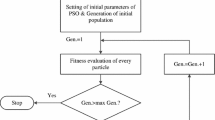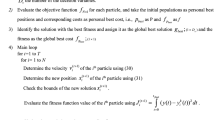Abstract
A new computational technique for the reduction of multi-time scale systems is proposed in this paper. The reduction process is performed based on the dominant poles preservation in the reduced-order model. The true dominant poles are selected based on the highest contribution in redefined time moments and lowest contribution in redefined Markov parameters. Motivated by the singular perturbation approximation, obtaining the reduced-order model will be achieved by using the artificial intelligent method named particles swarm optimization. The potential of the proposed technique is observed when comparing its results with other recently published methods.





Similar content being viewed by others
References
D. Abu-Al-Nadi, O. Alsmadi, Z. Abo-Hammour, Reduced order modeling of linear MIMO systems using particle swarm optimization, in The Seventh International Conference on Autonomic and Autonomous Systems (2011), pp. 62–66
D. Abu-Al-Nadi, O. Alsmadi, Z. Abo-Hammour, M. Hawa, J. Rahhal, Invasive weed optimization for model order reduction of linear MIMO systems. Appl. Math. Model. 37, 4570–4577 (2013)
A. Adamou-Mitiche, L. Mitiche, Internal projections and L2 norm for optimal digital filters model reduction: a comparative study. J. Circuits Syst. Comput. 28(1), 11–19 (2019)
O. Alsmadi, Z. Abo-Hammour, A. Al-Smadi, Robust model order reduction technique for MIMO systems via ANN-LMI-based state residualization. Int. J. Circuit Theory Appl. 40, 341–354 (2012)
O. Alsmadi, Z. Abo-Hammour, A. Al-Smadi, D. Abu-Al-Nadi, Genetic algorithm approach with frequency selectivity for model order reduction of MIMO systems. Math. Comput. Modell. Dyn. Syst. 17, 163–181 (2011)
O. Alsmadi, D. Abu-Al-Nadi, Z. Abo-Hammour, Particle swarm optimization for MOR of singularly perturbed systems with critical frequency preservation and application to power systems simplified modeling. J. Circuits Syst. Comput. 23(5), 1–20 (2014)
A. Al-Smadi, O. Al-Smadi, M. Marji, Dominant-dynamics-based reduced order modeling using genetic algorithm. Int. J. Control Syst. Robot. 1, 96–100 (2016)
F. Casenave, N. Akkari, An error indicator-based adaptive reduced order model for nonlinear structural mechanics—application to high-pressure turbine blades. Math. Comput. Appl. 24, 1–28 (2019)
S. Deepa, G. Sugumaran, MPSO based model order formulation technique for SISO continuous system. Int. J. Eng. Appl. Sci. 7(3), 125–130 (2011)
Z. Gallehdari, M. Karrari, O. Malik, Model order reduction using PSO algorithm and it’s application to power systems, in International Conference on Electric Power and Energy Conversion Systems, 2009. EPECS ‘09, 2009, pp. 1–5
F. Golnaraghi, B.C. Kuo, Automatic control systems (Wiley, London, 2010)
Y. Guardia, I. Acle, F. Damasceno F., N. Martins, J. Rommes, Parameter preserving model order reduction of large sparse small-signal electromechanical stability power system models. IEEE Trans. Power Syst. 34(4), 2814–2825 (2019)
J. Kennedy, R. Eberhart, Particle Swarm Optimization, Proceedings of the IEEE Conference on Neural Networks IV (Piscataway, 1995), pp. 1942–1948
Z. Li, Z. Zhu, Y. Song, Z. Wei, Amulti-objective particle swarm optimization with distance ranking and its applications to air compressor design optimization. Trans. Inst. Measur. Control 35, 546–556 (2012)
X. Liang, J. Xia, G. Chen, H. Zhang, Z. Wang, Dissipativity-based sampled-data control for fuzzy Markovian jump systems. Appl. Math. Comput. 361(15), 552–564 (2019)
A.K. Mittal, P. Prasad, S.P. Sharma, Reduction of linear dynamic systems using an error minimization technique. J. Inst. Eng. IEI J. EL 84, 201–206 (2004)
S. Mukherjee, M. Satakshi, R.C. Mittal, Model order reduction using response matching technique. J. Franklin Inst. 342, 503–519 (2005)
G. Parmar, S. Mukherjee, R. Prasad, System reduction using factor division algorithm and eigen spectrum analysis. Appl. Math. Model. 31, 2542–2552 (2007)
R. Reyes, R. Codina, J. Baiges, S. Idelsohn, Reduced order models for thermally coupled low Mach flows. Adv. Model. Simul. Eng. Sci. 5(28), 1–20 (2018)
G. Saraswathi, A modified method for order reduction of large scale discrete systems. IJACSA 2, 159–162 (2011)
S. Tomar, R. Prasad, Conventional and PSO based approaches for model order reduction of SISO Discrete systems. Int. J. Electrical Electron. Eng. 2, 45–50 (2009)
X. Wang, M. Yu, The error bound of timing domain in model order reduction by Krylov subspace methods. J. Circuits Syst. Comput. 27(6), 1–19 (2018)
J. Xia, G. Chen, J.H. Park, H. Shen, G. Zhuang, Dissipativity-based sampled-data control for fuzzy switched markovian jump systems,IEEE Trans. Fuzzy Syst. (in press). https://doi.org/10.1109/tfuzz.2020.2970856
J. Xia, J. Zhang, J. Feng, Z. Wang, G. Zhuang, Adaptive fuzzy control for nonlinear systems with unknown control directions. IEEE Trans. Syst. Man Cybernet. Syst. (in press). https://doi.org/10.1109/tsmc.2019.2911115
Acknowledgements
The authors would like to greatly appreciate the anonymous reviewers for their valuable comments. Their comments have substantially strengthen the presentation of this paper.
Author information
Authors and Affiliations
Corresponding author
Additional information
Publisher's Note
Springer Nature remains neutral with regard to jurisdictional claims in published maps and institutional affiliations.
Rights and permissions
About this article
Cite this article
Alsmadi, O., Al-Smadi, A. & Ma’aitah, M. Model Order Reduction with True Dominant Poles Preservation via Particles Swarm Optimization. Circuits Syst Signal Process 39, 5501–5513 (2020). https://doi.org/10.1007/s00034-020-01443-5
Received:
Revised:
Accepted:
Published:
Issue Date:
DOI: https://doi.org/10.1007/s00034-020-01443-5




